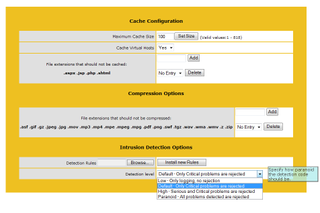Paessler's Webserver Stress Tool and configured it to simulate 2,000 users each clicking on a web page every five seconds. With the load ramped up we could see from the LoadMaster's statistics page that all requests were being evenly distributed across the real servers and during this test Paessler detected no errors.
We also created a virtual FTP server using our three real servers each with an identical download folder containing 6GB of test data. We logged on to the virtual server from three different clients using the FileZilla utility and while downloading the test folder saw that each had been sent to a different real server.
Using the Kerio Connect mail software we also created a virtual server for web mail. Our clients were able to connect normally to the virtual server where they were presented with the standard secure login page and were none the wiser that they were being load balanced.
Other useful features include the option to cache static web content in RAM for faster responses and the ability to apply GZIP compression to HTTP objects. Basic intrusion prevention is also available as the appliance uses SNORT rules to check incoming web traffic and block anything malicious from reaching the real servers.

The 3600 can cache and compress web content and uses SNORT rules to provide intrusion prevention measures.
For the price, the LoadMaster 3600 is a well specified application delivery controller that beats Barracuda's Load Balancer 640 hands down on value. It's easy enough to deploy and offers an impressive selection of features for controlling load balancing and connection persistence.
Verdict
The LoadMaster 3600 beats most of the competition at the value end of the server load balancing market as it offers an excellent range of features. A traffic throughput of 3.4Gbit/s and 5,000 TPS SSL acceleration rates are also exceptionally good at this price point. Our only gripe is the need for Kemp to address the use of VMs as physical servers and bring in some load balancing features specifically for these environments.
Chassis: 1U rack CPU: 2.67GHz Intel Core 2 Quad Q9400 Memory: 4GB DDR3 Storage: Transcend 512MB DOM Network: 8 x Gigabit Ethernet Other Ports: VGA, serial, 2 x USB2 SSL Acceleration: Cavium Nitrox PX CN1610 PCI Express card Power: 200W fixed supply Management: Web browser
Dave is an IT consultant and freelance journalist specialising in hands-on reviews of computer networking products covering all market sectors from small businesses to enterprises. Founder of Binary Testing Ltd – the UK’s premier independent network testing laboratory - Dave has over 45 years of experience in the IT industry.
Dave has produced many thousands of in-depth business networking product reviews from his lab which have been reproduced globally. Writing for ITPro and its sister title, PC Pro, he covers all areas of business IT infrastructure, including servers, storage, network security, data protection, cloud, infrastructure and services.













